

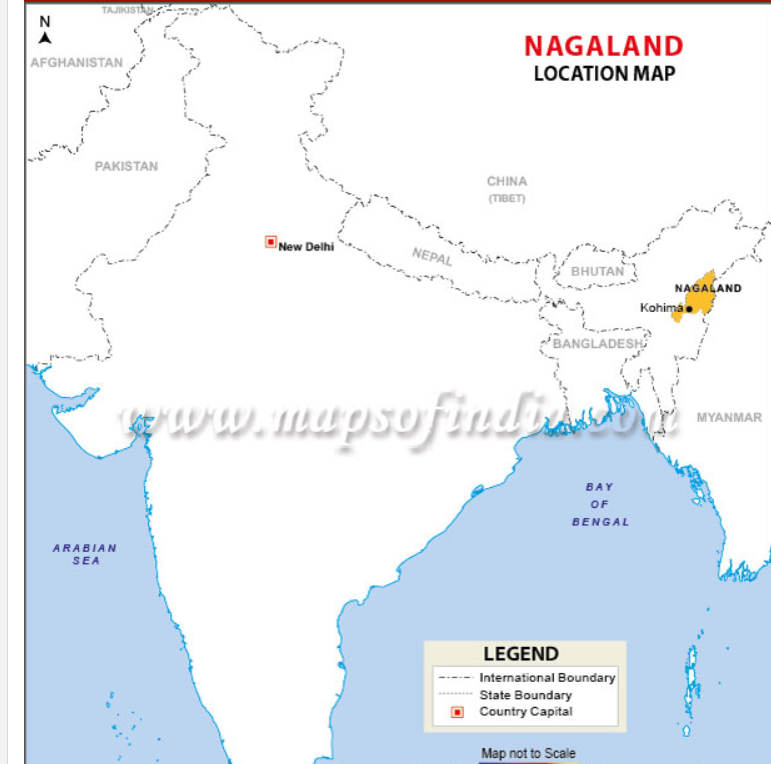
The story of this land and its people began thousands of years ago when the ancestors of the Nagas settled in the present state of Nagaland.

Their history is full of adventure, music, art, wars and peace. During the early period of Naga settlement until the entry of British Adventurers, Nagas were mostly unknown to the rest of Indian sub-continent.

No king or the Emperor from Indian-subcontinent or outside ever established rule in Naga Region. Even the Britishers failed to control these fearless warriors and their hostile terrain.
Once the British left the Indian sub-continent, the struggle of Naga people began.
The Nagas are very friendly to outsiders in spite of having a totally different culture and having endured struggle and oppression. Tourists visiting this state should read up the history of the struggle of Naga people. We owe them this much !
DIMAPUR

We had read up feverishly, all we could about Nagaland. March, the guide book said, would be from pleasant to cool. So packed with some light woolens and not bothering to clarify with our tour operator (Alder Tours and Travels) whether our tour vehicle was air-conditioned or not, we landed gleefully in Dimapur.
We were met by a mild mannered personal guide - Asou (provided by Mr. Keja, our tour operator) and not so mild hot weather at the Dimapur airport. We got into the van with mixed feelings, the sun beating down mercilessly and my sister's expression was beginning take on a look of irritation. She had come all the way from the USA expecting a cool weather. After spending years in the US, she could no longer stomach Indian summers !! Just so that she would feel better, I inquired with our guide whether the van AC was working, although we all knew that it wasn't !! He tried to console us by saying that it would get so cold by the time we reach our next destination that we would need our jackets !! Of course, none of us believed him and I made a mental note to call up Mr. Keja, to do something about the A.C.


BENRUE VILLAGE: Life is tough
But it turned out that Asou was right and by the time we were close to our next destination- Benrue village, it was almost freezing !! Asou informed us that terrain-wise and therefore climate-wise, Dimapur is more akin to Assam than it is to Nagland.

Benrue is perched at an altitude of 1,950 meters above sea-level. According to our guide, Benreu is an eco-friendly green village surrounded by nature. Located on a hill, of the third highest mountain, Mt Pauna in Peren District of Nagaland. The village has rich forest resources and abundant flora and fauna.

According to Wikipedia has 37 tribes and among these, Zeliang and Kuki tribes are the oldest and permanent tribes to inhabit Peren district.

Our stay the Community Cottage was a bit disappointing. There was irregular water supply in the washrooms. The food was below average.


Perched atop a hill range in a serpentine formation, life in this village is is not easy. The main economic activities in Benrue, as in most the villages of Nagaland, is agriculture. Jhum and terrace cultivation on these cold hills is not easy and these hardy people have a tough life tending to their livestock and fields, fetching fodder and firewood and with heavy monsoons, their huts and cottages are in constant need of repair.

It was in Benrue that we first encountered the unique and impressive culture of the Naga people .
The mithun (gayal) or the Indian bison (Bos fontalis) is synonymous with Naga culture. Mithun are semi-domesticated, have a designated owner and are reared in fenced-off tracts in the wild. It is the state animal of both Nagaland and Arunachal Pradesh.

The mithun head or horns are almost a signature of Naga architecture inasmuch as they overshadow all other motifs in their magnificence and variety especially in the vernacular wooden architecture of the many tribes of Nagaland. The mithun is a powerful symbol of wealth, prosperity and fertility and dignifies house façades in the form of mithun head carvings which traditionally declared the social status of the owner.

The Morung or the bachelor dormitory system was an essential part of Naga life. Apart from the family, it was the most important educational set up of the people for both the boys and girls.

Hunting and craftsmanship were among the skills taught in these Morungs. Much of Naga cultures, its customs and tradition have been transmitted from generation to generation through folk music and dance, folk tales and oral traditions, carvings of figures on stones and wood, and designs on clothes. The Morung was also used as a guard-house during times of war.

The landscape of Nagaland is dotted with monoliths, erected stones of variable sizes. Monoliths were simply part of the Nagas tradition to mark some important events, or could even be as insignificant as showing off their wealth. Erecting wooden or stone monoliths were done usually by the rich to demonstrate their status and wealth.

Anyone could erect monoliths, but such acts were always accompanied with feeding the whole village at least once. In some cases the whole village had to be fed twice or thrice before erecting such stones.These monoliths are the oldest historical relics of the Nagas.


In more recent times the memorial stones resemble the epitaphs that depict the major achievement and social status of a deceased person.


On the way to our next village Dzuleke, we stopped briefly at a famous picnic spot at Kingam gorge.



DZULEKE VILLAGE: Women Power
This village is unique, not only for its flora and fauna but also because this village has banned hunting to protect wildlife.

Dzuleke village is about 40 km from Kohima . The village gets its name from the river Dzuleke that, during its course, goes underground once it reaches Dzuleke. ‘Dzu’ means water and ‘leke’ means underground in the local language. This is an Angami village. The Angamis are one of the dominant tribes in Nagaland.

Women in Nagaland, as elsewhere in the hilly regions of India, are very hard working, running small shops, home stays and tending to the fields.



Apart from enjoying the local cuisine, visitors in Dzuleke can go on short hikes in the surrounding forests and see the fishing of the rare snow trout in the river.







DZUKOU VALLEY: Call of the Wild
Our next destination was Dzukou Valley . This beautiful valley is located on the Barail mountains, at the border of the states of Manipur and Nagaland .
There has been disputes for years between the two states of Nagaland and Manipur regarding the ownership of Dzukou Valley.

'Dzükou' means 'cold water' in Angami, one of the 16 main languages spoken in Nagaland , referring to the cold water running through the serpentine streams in the valley.

The valley is fully covered with a stout Himalayan bamboo and when viewed from the hill top looks similar to a golf course.

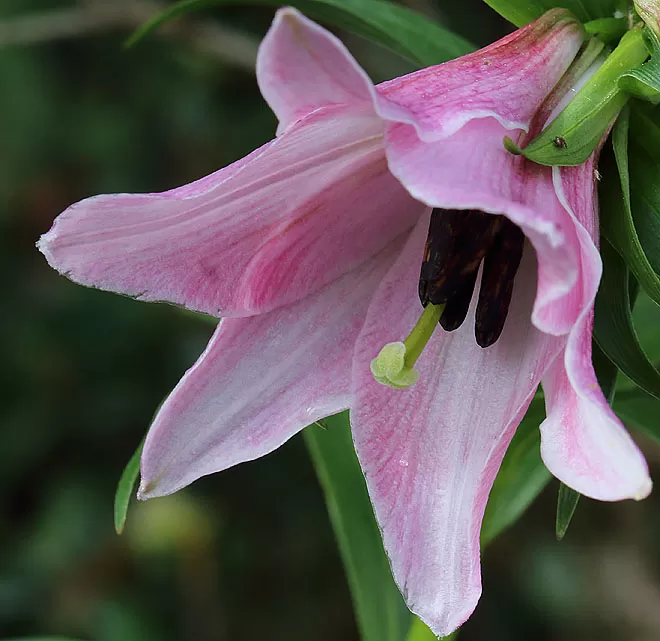
This valley , transforms into a spectacle with lilies and rhododendrons during July to September. The rare Dzükou lily (Lilium chitrangadae) is found here.

The main entry from the foothills of Viswema village where one can travel to the rest house above Mt. Teyozwü by a Tata Sumo taxi. From here one has to climb forty minutes to the top of the mountain. This is where Dzüko starts but the main valley is still another two hours walk away. One can exit the valley from the same route but if one is planning to come back by foot, the Jakhama route is shorter. Also it can be reached in five hours of trek from Mt. Isii of Senapati district of Manipur. The new five-hour trek route was opened by MMTA (Manipur Mountaineering and Trekking Association).

This valley is well known for its natural environment, seasonal flowers and flora and fauna. It is situated at an altitude of 2452 m above sea level.

The trek is moderately tough and requires some basic fitness and stamina to cover it.

KHONOMA: A Lesson in Sustainable Living
Khonoma village is located about 20 km from the state capital, Kohima. The village, referred to as Khwunoria (named after the Angami term for a local plant, Glouthera fragrantisima), is estimated to be around 700 years old and is spread over an area of 123sq.km.

Mr. Keja, our tour operator put us up at Pier's Vantage Homestay, a very cosy home stay atop a ridge over looking the terraced fields below.


The Nagas are very fond of planting flowering plants in and around their house. Our hostess at the Vintage Homestay was no exception.



Khonoma prides itself for being a green village but what impressed me most was its self-sufficient and eco-friendly way of life.

Their self-sufficient way of life includes sustainable management of resources and non-chemical agricultural practices. They grow their own grains, fruits, vegetables and condiments such as rice, apple, peach, tubers, mint, garlic, onion etc. A special variety of tree tomato and cabbage grow here. Pigs are reared in every household and are a source of meat and manure for the fields.Firewood is still the chief source of fuel and every house has piles of dried logs kept in their front or backyards.


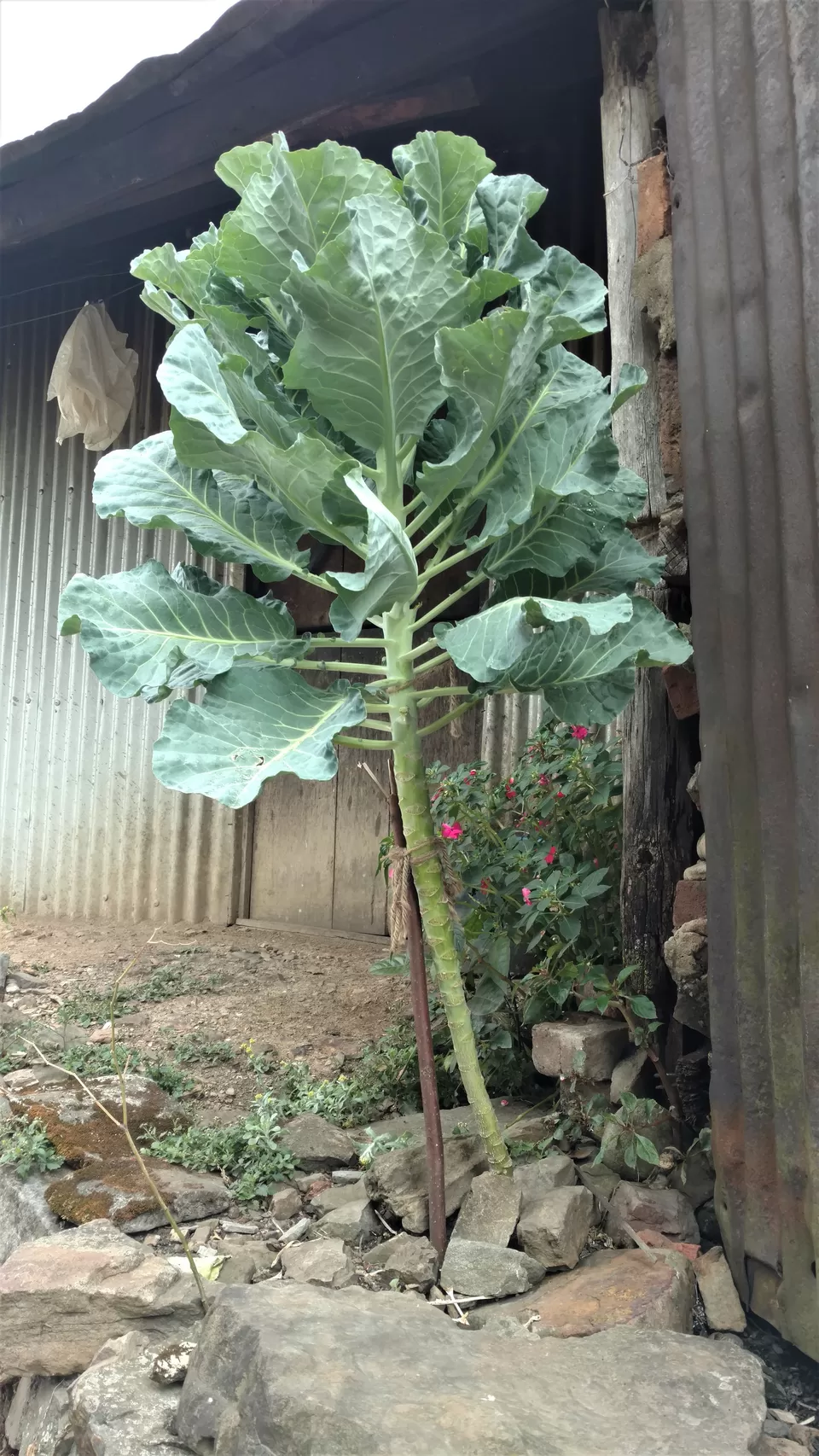


Khonoma is famous for its unique form of agriculture, including some of the oldest terraced cultivation in the region. The terrain of the village is hilly, ranging from gentle slopes to steep and rugged hillsides.

The village is uniquely placed on a hill range with a river flowing in the valley below. This valley has been very innovatively used by the villagers for over hundred years for terrace cultivation.

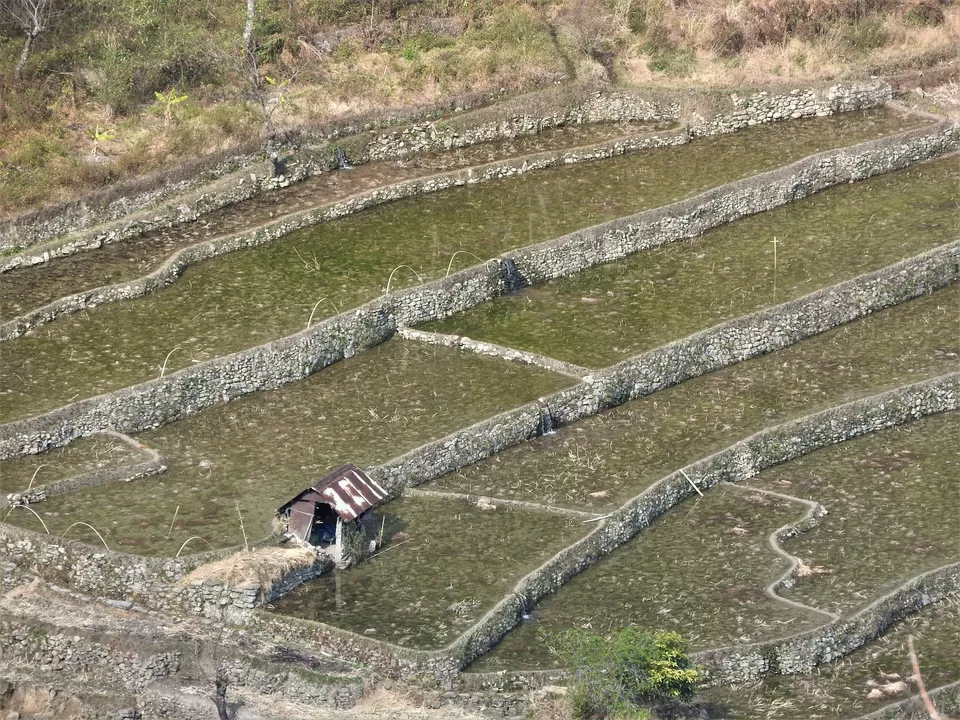

Apart from rice, tobacco, oilseeds, pulses, fibers, potato, green vegetables and sugarcane, snail and fish cultivation is also practiced in these fields.


Jobs Tears (Coix lacryma-jobi) is a great little grain that grows and looks and tastes like a cross between rice and corn. Nagas like to fry it, puff it and eat it as a snack with tea, or drizzled with honey for breakfast. It is also steamed like rice for dinner. Job's tears is high in protein content and is gluten free. The Nagas also use the grain for brewing a beer called zhu or dzu.

Martin, a local resident took us around the fields on the first day. He is training to become a regular tourist guide. In spare time he helps out his parents in the fields .

All the stone steps in the villages and fields were hand made by the Angamis and many of them are over hundred years old.


This all-encompassing attitude toward conservation is also reflected in the way Khonoma’s other natural resources have been managed over the centuries. The hillslopes surrounding the village are dense with Himalayan alder (Alnus nepalensis), a tree capable of channelising atmospheric nitrogen into the soil. The villagers grow vegetables at the foot of alder trees.

To ensure the ability of this practice to continue, a site with alder trees is cleared of underbrush to grow vegetables for a couple of years and then left fallow for four to six years to allow the soil to rejuvenate.

The hills of Khonoma are covered with lush forestland, rich in various species of flora and fauna. The state bird, Blyth’s tragopan, a pheasant now nationally endangered, is reportedly found here.

In December 1998, hunting was banned in Khonoma’s forests after a 20-square-kilometer (8-square-mile) area was demarcated by the village council as the Khonoma Nature Conservation and Tragopan Sanctuary (KNCTS).
For the members of the Angami tribe that call Khonoma home, hunting was not a source of income — it was a sacred cultural practice. The hunter himself would never eat what he hunted, it was believed to bring bad luck. Instead, he would feed his family and friends with it. The hunting ban called for a huge shift in the lifestyle of the Khonoma people.

This village also serves as a good lesson in community living. In the village one comes across several stone circles -a place called Dahu, where small stones are arranged in a circle, with a bigger slab in the center. This serves as the village meeting place. Dahus are usually built in front of the house of a village elder or a raised place from each everyone can hear any announcements being made.

Nagaland as a whole, is vibrant with a rich architectural wood craft tradition which has its roots in an animistic past: a lost culture of magnificent huge wood-carved building façades and village gates with the mithun horns and head dominating all else with their immense visual appeal.

The mithun head and house horns were the most powerful wood-carved elements, especially among the Angami and Chakhesang and to a lesser extent, the Ao and Sumi (Sema) tribes.

We were told that the locals bury their dead relatives right outside or underneath their homes, as is their tradition. It is their belief that the dead ones should always be closer to their dwelling places.


Over a hundred years ago, advancing British troops found themselves facing a determined warrior tribe in the highlands of Nagaland. The Angami men of Khonoma, famed for their martial prowess and strategic skills, fought a resolute battle to safeguard their territory, inflicting heavy casualties on the foreign soldiers.

The village is recorded to have resisted British rule in the region from 1830s to 1880. The fiercest battle was fought between the Angamis and the British betwee 1850-1879 in the Semoma fort of Khonoma. This fort was described as the strongest in the Northeast by Major John Butler of the British army.

Finally a truce between the two stopped further bloodshed, but meanwhile Khonoma village had etched its name into the history of Indian resistance to the colonial invasion.


Khonoma is also known for its long rifle guns which can be up to seven feet long. These guns are over 200 years old and were used by the tribes of Khonoma in many battles.

LOCAL MARKET


KOHIMA WAR CEMETERY

During the second World War, the Japanese advance into India was halted at Kohima in April 1944 and Garrison Hill, a long wooded spur on a high ridge west of the village, was the scene of perhaps the most bitter fighting of the whole Burma campaign when a small Commonwealth force held out against repeated attacks by a Japanese Division. The fiercest hand to hand fighting took place in the garden of the Deputy Commissioner's bungalow, around the tennis court, but the heaviest casualties on both sides occurred after relieving forces reached the Garrison and the Japanese were driven off the ridge, so re-opening the road to Imphal. KOHIMA WAR CEMETERY lies on the battle ground of Garrison Hill.


The cemetery has 1420 burials of Commonwealth soldiers out of which 1270 are identified. At the highest point of the terraced cemetery shoots out a cremation memorial commemorating 917 Hindu, Muslim and Sikh soldiers who also fell in that horrible battle. Unfortunately the Wikipedia article on this War Cemetery (https://en.wikipedia.org/wiki/Kohima_War_Cemetery) as well as the Common Wealth Graves Commission (https://www.cwgc.org/…/cemetery/2058100/kohima-war-cemetery/), mentions Hindu and Sikh soldiers and forgets to mention that there were Muslim soldiers too, among those who sacrificed their lives. Sad.


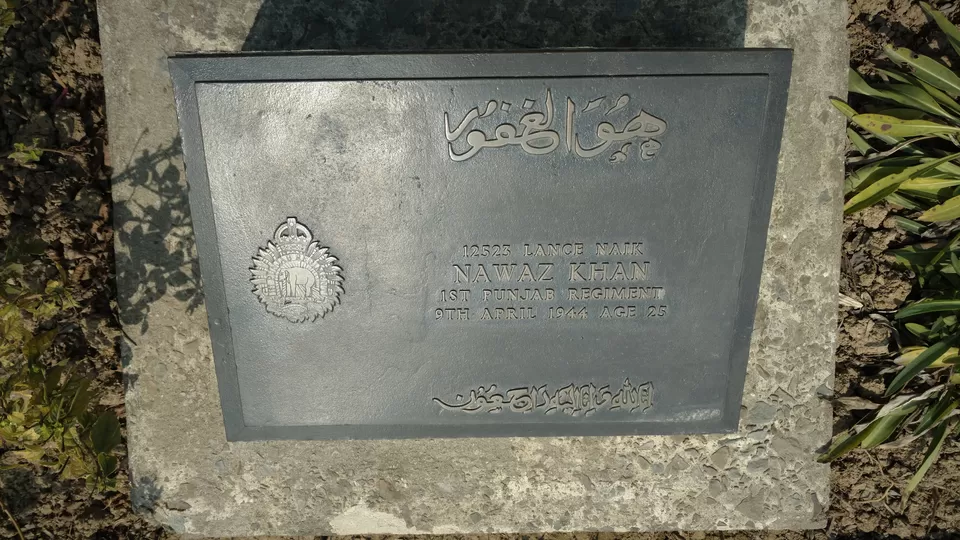
Ironic isn't it, how war can be a unifying factor. Graves of martyred soldiers at the War Cemetery in Kohima, Nagaland show that neither religion nor caste prevented them from fighting for a common cause. The headstones belong to Christians, Jews, Muslims, Sikhs and Hindus belonging to different castes. And today, in times of 'Peace' we are a divided nation...


NAGALAND STATE MUSEUM, KOHIMA
The museum displays the rich history of the state. One of the prominent attractions of the museum is the unique artifacts of the sixteen tribes that live in the state. The artifacts displayed here include traditional dresses, jewelries, carved gateposts, inscriptions, ancestral weapons, ceremonial drum, musical instruments and sculptures of birds and animals
There are also on display models of Naga Morungs (huts) and paintings by local artists.

Headhunting was once an institutionalized cultural practice among all the Naga tribes which had social and religious sanction. A Naga method of fighting and headhunting was a combination of individual enterprise and teamwork. Individual bravery was greatly admired and each warrior sought to distinguish himself by taking as many heads as possible. Every Naga aspired to take an enemy’s head and flaunt his bravery for it not only brought him prestige, honor and entitlement to wear the much coveted warrior’s paraphernalia but in killing an enemy he was ensuring the survival of the village.


THE CATHEDRAL OF KOHIMA
The Cathedral of Kohima (Mary Help of Christians Church) is the church of the bishop of the diocese of Kohima, and the main church of this diocese of Nagaland. The church is noted for its architecture which incorporates many elements of traditional Naga houses, including its facade which resembles that of a Naga house. The 16 feet high carved wood crucifix is one of Asia's largest crosses.

The cathedral was conceptualized by the first bishop of Kohima, Abraham Alangimattathil. The cathedral complex also contains Bishop Alangimattathil's tomb.

The construction commenced in 1986 and the church was consecrated in January 1991. The three-crore expense for constructing the cathedral was mostly funded by Japanese people who wished to construct a monument to the Japanese soldiers who died in the Battle of Kohima during the Second World War.

The cathedral was used as the venue for reconciliation meetings between the Japanese and British veterans who fought each other during the war.
The cathedral has incorporated many tribal insignia's in its design.

The cathedral was used as the venue for reconciliation meetings between the Japanese and British veterans who fought each other during the war.
The cathedral has incorporated many tribal insignia's in its design.


KISAMA, NAGA HERITAGE VILLAGE: Of Tribes and Totems
Kisama Heritage Village, lies on the outskirts of Kohima. A must-visit for all tourists. Kisama is Nagaland in its miniature form. Since the 16 tribal communities of Nagaland live in different regions of the state, this heritage village serves as a a window to their world, in one complex, with 16 houses designed according to the indigenous architectural concepts of the 16 tribes. The Hornbill Festival, held here during the first week of December every year, is the season to be in Kisama, to have a glimpse of Naga life in all its glory !



KIGWEMA VILLAGE
Located on the foothills of the state’s second-highest mountain peak Japfu (3,048m), Kigwema is a village of around 700 Angami families .

The village has a history associated with the Japanese that goes back to World War II, when British and Indian forces fought the Imperial Army during the Battle of Kohima in 1944.


According to Naga tradition, the most prosperous member of the tribe organized a village feast, called 'Feast of Merit', where large number of mithun were killed and offered as feast.
The social status of the Nagas depended largely on the ability of an individual to provide feasts. The performance of these series of feasts was optional but the continual quest for prestige in the Naga society encouraged and at the same time provided every married man, an equal opportunity to compete for status through the feasts of merit. These ceremonies also ensure that the wealthy individual shared and redistributed his accumulated wealth with his fellow villagers who were less fortunate thereby creating a balance in the society.
V1

The number of mithun skulls hanging on the hut of the person indicated the extent of his wealth. This of course was followed by the erection of a memorial stone.

We also visited the Kigwema Baptist Church and talked to the priest, who informed us that the church was actively involved in community welfare work in the village.



Compared to the other villages that we had visited, Kigwema appeared to be not that well planned.
Kigwema is one of the oldest villages in Nagaland and ancestors of most other Naga villages have come from Kigwema.

Loho lake, Chida area
The Loho lake, Chida area is a popular picnic spot and attracts people from both the states of Nagaland and Manipur. This place is in under Phek district, near Khezhakeno village.


On the last day we waved goodbye to Nagaland and our guides Asou and Aviko and flew back to New Delhi from Dimapur.
Following are two videos of the song and music night in front of the bonfire at Dzuleke homestay with our Naga hosts and guides:
Photo credits: Rupa and Razi Abdi
How to get there:
By Air:
Dimapur Airport is the only airport in Nagaland with regular Air India Regional, IndiGo, and Air India flights operating from Dibrugarh, Delhi, and Kolkata. For international flights, you will have to reach Lokpriya Gopinath Bordoloi International Airport in Guwahati or Netaji Subhas Chandra Bose International Airport in Kolkata. From Guwahati, and Kolkata, you can easily get overnight buses to reach Nagaland.
By Railway:
Dimapur railway station on the Lumding-Dibrugarh section in the only railway station in Nagaland.
Where to stay:
If you want to experience genuine Naga culture then home stays are the best. There are some good tour operators in Nagaland who will plan your trip and arrange your home stay accommodation based on your budget and interests. We used the services of Alder Tours & Travels who can be contacted at the following website:
http://www.aldertoursntravels.com/
Mr. Keja arranged our tour and our local guide for the entire trip was Mr. Asou Savino. Both these gentlemen were very helpful and made our tour a pleasant experience. Our driver Aviko and local guide Martin at Khonoma left us with pleasant memories.
When to travel:
The best months to visit Nagaland are between October and May, when the landscape wears a green carpet and the flowers are in full bloom.
A 21st century creation of Nagaland is the Hornbill festival, an event which is now getting known globally. During this festival, which takes place on the first week of December, the entire Naga culture is showcased in full splendor in the Kisama village of Kohima district.
My other articles on Nagaland on Tripoto:
- NAGALAND II: THE NAGA TRIBES- Our Own Game of Thrones
- NAGALAND III: The Mithun and the Hornbill - Motifs and Wood Craft of Nagaland
NAGALAND IV: The People of Nagaland-Proud and Honest
- NAGALAND V: Beyond the Hornbill Festival





